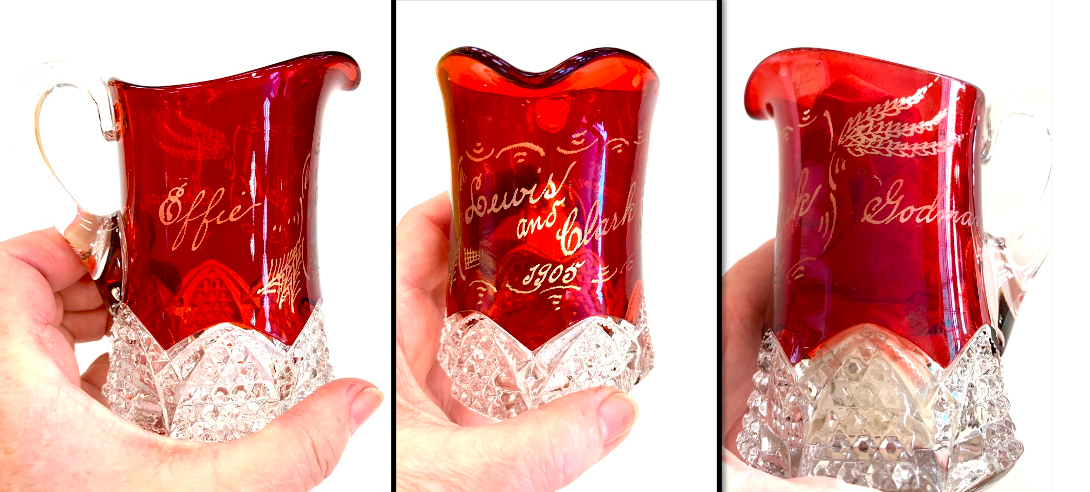Ruby Flash GlassStriking “Ruby Stain” or “Ruby Flash” glass often comes to our sales as individual pieces, rather than sets. This is because much of it was made as souvenirs or gifts intended to be custom-etched at the buyer’s request. If you’re a purist, you know that ‘Ruby Flash’ and ‘Ruby Stain’ are similar but not identical manufacturing methods conflated together by most collectors but antique dealers do distinguish between them, so while pieces here are officially Ruby Stain, most collectors would call them Ruby Flash. There were lines of tableware produced in Ruby Flash, such as this pedestal compote bowl by Indiana Glass in the Kings Crown Thumbprint pattern. There have been other red table wares such as pinkish Cranberry glass and ruby-red lines sold by Avon and French glass manufacturer Arcoroc in the 1970 – 80s.
Glass is colored by mixing chemicals into a clear base, with different formulas for each color. The first reds were achieved by adding actual GOLD to the mix, which made red expensive. Ruby Stain is an alternate method where each piece was coated in copper sulfide solution and then fired in a kiln, fixing the coating and turning it red. On the plus side the coating is thin, easily allowing hand-engraving, and it’s a cheap red. On the minus side, over time scratches may start to show.
Engravers used foot-pedal powered grinding wheels coated in abrasives to score designs into the glass, manipulating each piece by hand. The resulting curving, slightly thick line favored cursive script, curlicues and florals, making Ruby Flash readily distinguishable from other engraved, colored glassware such as expensive Czech-made Bohemian glass which was “cased” (blown in two layers, one colored, one clear) and then “cut” (engraved with diamond files) resulting in sharp, clean, straight lines.
|
| Ruby Flash imitated lavish glass at a price many could afford. Pieces ranged from big (like this commemorative water pitcher) to tiny (toothpick holder monogrammed “JMG”) with most in the category of items (or pairs of items) that you’d use singly, like cream & sugar sets, or salt & pepper sets, candy bowls, vases or spooners (for holding your spoons, naturally) so gifting just the one was fine. And, just about every style of drinking glass was made, too. Most American Ruby Flash souvenirs date to a narrow window from the 1890’s through 1920’s, when the country fell into an economic depression that killed off the market for such frivolities.
Ruby Flash was sold at places tourists passed through, like train stations, attractions, or big events like state fairs. Thus you’ll often find them engraved with date, place, and title of the event if applicable, making them easy to date. The buyer’s name or the name of the intended recipient were also popular themes; just look at this adorable little cup engraved “Dear Mother, 1912”.
Another fine souvenir is this pitcher engraved “Lewis and Clark, 1905,” with the name “Effie Godman”, bracketing the title. Oregon’s only World Fair, the “Lewis and Clark Centennial and American Pacific Exposition and Oriental Fair” ran in Portland, June – October 1905, showing off everything the PNW had to offer the world. Oregon’s close proximity to Asia (relatively speaking) and the prospect of facilitating international trade was a major selling point for the state, impressing some 1,588,000 visitors. In all, 21 countries staged exhibits and Japan’s, at a million dollars, was the biggest. PNW businesses Northern Pacific Railroad and beer brewer Henry Weinhard were major backers. There are still a few statues in Portland left over from that fair. Want your own Ruby souvenir? Visit QBO!
|






